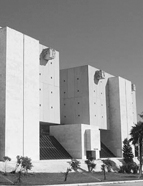

................................
In truth, during the nearly half-century of apathy that hung over the Torre do Tombo, the only noteworthy effort to change the state of affairs was made by António Ferrão. However, despite his dedication, his proposed reorganisation by “homogeneous groups” was not realised, nor is there any record of measures being taken to physically or intellectually reconstitute the holdings of the National Archive, apart from the work initiated in 1962 under the interim direction of the first conservator, José Gaspar de Almeida, aimed at creating a “guide to the archive,” which was never published. It was only in the late 1970s that the archive’s problems began to be addressed realistically and effectively, with a commission being appointed in 1977 to study the design programme for the building intended to house the archive, and in 1980, a decision was made regarding the site where it would be built.
Regarding the processing of the collection, it was not until 1984 that the Roteiro de fontes da História Portuguesa Contemporânea was published. This work addressed the lack of access tools for the archives incorporated into the Torre do Tombo, particularly those from the contemporary era. Historical studies on this period experienced significant growth after April 25, 1974, but historians found themselves greatly hindered in their research due to the lack of access to documentary sources, a consequence of the absence of appropriate research tools . The two volumes produced on the National Archive were an invaluable contribution that, although described by their authors as merely aiming to “guide users in consulting the Archive,” served as a comprehensive guide and addressed a significant gap. Equally important was the publication of Decree 424/85 on October 22, which promulgated the organic law of the Torre do Tombo, revoking the 1902 regulation. From a legal standpoint, this decree established the essential minimum conditions for the modernisation of the National Archive. It also granted the archive administrative autonomy, separating it from the oversight of the Portuguese Institute of Cultural Heritage, which previously supervised archival matters .
This work is financed by national funds through FCT - Foundation for Science and Technology, I.P, in the scope of the projects UIDB/04311/2020 and UIDP/04311/2020.
